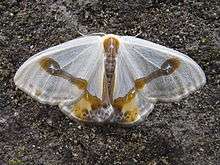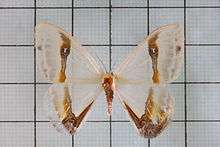Macrocilix mysticata
Macrocilix mysticata is a moth in the family Drepanidae first described by Francis Walker in 1863. It is found in India, Myanmar, Taiwan, Japan and China.[1]
| Macrocilix mysticata | |
|---|---|
 | |
| Macrocilix mysticata watsoni | |
 | |
| Macrocilix mysticata watsoni | |
| Scientific classification | |
| Kingdom: | |
| Phylum: | |
| Class: | |
| Order: | |
| Family: | |
| Genus: | |
| Species: | M. mysticata |
| Binomial name | |
| Macrocilix mysticata (Walker, [1863]) | |
| Synonyms | |
| |
The wingspan is 31–38 mm. Adults are on wing in March and August.[2]
The larvae feed on the leaves of Castanopsis formosana and Pasania konishii. Mature larvae spin silk and curve the leaf, making a compact oval, whitish cocoon where pupation takes place.[3]
Subspecies
- Macrocilix mysticata mysticata (northern India, Sikkim, Myanmar)
- Macrocilix mysticata brevinotata Watson, 1968 (China: Sichuan)
- Macrocilix mysticata campana H.F. Chu & L.Y. Wang, 1988 (China: Sichuan, Chejiang, Jiangxi, Guangxi, Fujien)
- Macrocilix mysticata flavotincta Wileman, 1915 (Taiwan)
- Macrocilix mysticata watsoni Inoue, 1958 (Japan, China: Fukien, Chekiang, Kwangtung, Yunnan, Sichuan)
gollark: Hmm, so have more levels than "run in sandbox" and "run out of sandbox"? Interesting.
gollark: That is also true of basically any unsandboxed function.
gollark: It's an extension of the signed disk thing, really.
gollark: > The primary benefit promised by elliptic curve cryptography is a smaller key size, reducing storage and transmission requirements[6], i.e. that an elliptic curve group could provide the same level of security afforded by an RSA-based system with a large modulus and correspondingly larger key: for example, a 256-bit elliptic curve public key should provide comparable security to a 3072-bit RSA public key. - wikipedia
gollark: For RSA, though.
References
- Savela, Markku. "Macrocilix mysticata (Walker, [1863])". Lepidoptera and Some Other Life Forms. Retrieved August 5, 2018.
- Lin, Felix. "Macrocilix mysticata flavotincta Inoue". Oriental Butterflies and Moths. Retrieved August 5, 2018.
- "Larval Morphology and Host Plants of Drepanidea (Lepidoptera: Drepanidae) in Southern Taiwan" (PDF). Archived from the original (PDF) on 2012-04-25. Retrieved 2011-12-19.
This article is issued from Wikipedia. The text is licensed under Creative Commons - Attribution - Sharealike. Additional terms may apply for the media files.